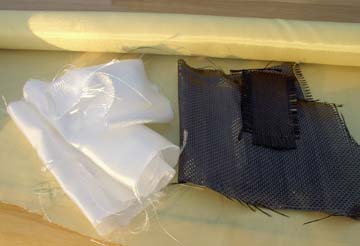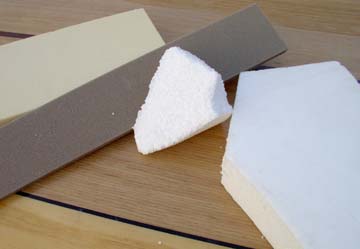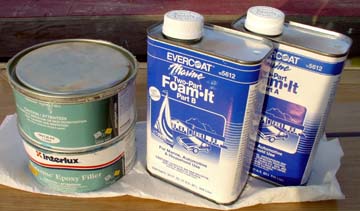|
| |
Repair Materials
 |
Epoxy resins, "regular" or UV-resistant, follow
directions exactly!! For proper mixing ratios, try calibrated pumps.
Epoxies come with different hardeners for different cure times, hardeners can
be mixed for custom blends. Epoxies produce a fair amount of heat when they
cure, the faster the gel time, the more exothermic they become.
Hardeners are fairly
hygroscopic, so keep the can closed! Once the West System hardener turns red,
it will inhibit the cure of the admixed Epoxy.
Epoxy resins freeze readily at modest temperatures, but can be restored
without ill effects by immersing the can in a warm-water bath.
Epoxies can cause debilitating skin irritations. Wear protective clothing!
|
 |
Q-Cells, milled fibers, and Cab-o-Sil are but a
few of the additives to make Epoxy into a filler. Some are harder than
others (milled fibers), some make for an easily handled paste (Cab-o-Sil),
none should be added to resin intended for laminations, since any filler
will reduce the structural properties of the resin.
In a pinch, talcum powder makes a decent filler. |
 |
Fiberglass, Carbon
and KevlarŪ come in many different forms and
weights. They are highly hygroscopic, so must be kept in plastic bags if the
environment is moist.
Fiberglass can cause contact dermatitis. Soaking in a
hot tub will rid your skin of the annoying little bits of itchy glass.
Carbon grinding dust will do terrible things to your lungs, so wear a
good mask!! Scissors to cut KevlarŪ need a very blunt cutting angle, and dull
after only a few feet. KevlarŪ tends to float up on resin, so I would not
recommend its use without a vacuum setup. |
 |
Divinycell foam is a cross-linked PVC. You can
cut it with a razor-blade. If you need to bend it around severe curves
(rails), you need to support it with tape, or peel ply, or both, or heat it.
Airex is a linear PVC foam, which is much more
pliable than Divinycell. It also is thermoplastic, so that the deck of your
dark-colored board will feel softer in hot weather than in cold.
EPS foam has few redeeming values in a board, and will melt when
exposed to such common shop substances as Styrene, Acetone, and Crazy Glue.
EPS foam sanding dust will drift around in your shop forever and amuse the
cats. XTR foam does not absorb water, but
exhales when warm. |
 |
To reinforce fractured
EPS foam, I use a Marine Urethane foam by Evercoat. As opposed to the stuff
from the hardware store that comes in a spray can, this foam does set up
hard. For filling, when I really, truly do not want to have
to deal with bubbles, I use an Epoxy filler by Interlux, "VC Watertite" |
back to
Repair Menu
|